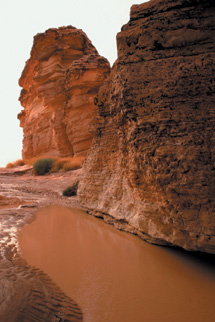Thoughts On Super Wide
Working With Sigma's 12-24mm f/4.5-5.6 EX DG Aspherical Lens
All Photos © 2004, Omar Attum, All Rights Reserved
Wide angle lenses are my favorite types of lenses. They allow me to create
striking 3D-like compositions, provide more depth of field, and fit more in
the photograph, even in confined spaces. Although I regularly use a digital
SLR, I often feel limited in using my Canon EOS 10D for landscape photographs
because of the camera's small sensor and resulting cropping factor. I
have to use my film SLR when I want to capture "wide" landscape
photographs that require the use of focal lengths between
20-24mm. This, of course, is not an issue if you can afford one of the more
expensive, full-sensor digital SLRs.
 |
 |
||
|
|
If you have never used a wide angle before, then you'd probably be surprised what a difference a decrease of 4mm from 24mm to 20mm or a 3mm decrease from 15mm to 12mm, such as is available from the Sigma 12-24mm, makes. The potential to see new angles and create striking compositions, in my opinion, increases as the focal length becomes wider. Being able to use a focal length of 12mm is like wearing glasses for the first time and being able to see the blackboard as a child. This is how significant a few millimeters decrease in focal length will expand your ability to see and create photographs.
 |
|
|
The 12mm of this lens is so wide on a film SLR that it probably won't be used all the time because of compositional difficulties--it seems that everything is included in the photograph because of the 122Þ angle of view. But the ability to zoom to 24mm allows this lens to be used for the entire range of wide angle applications. To create stunning compositions at 12mm, I used the compositional rule of "foreground/background." I often focus closely on an object in the foreground, such as wildflowers, to create dramatic landscapes that convey depth, since objects in the foreground appear larger than they really are in relation to the background. When using this lens at 12mm, pay attention to objects, such as branches and bright objects in the corners, bottom, and very top of the image that are distracting and are often inadvertently included in the image because of the extreme angle of view.
 |
|
|
That said, Sigma's 12-24mm f/4.5-5.6 lens is wider than any lens I have
ever owned. I worked with this lens on my Canon EOS-3 film and EOS 10D digital
SLRs during a two-month desert excursion to Saudi Arabia. The Sigma 12-24mm
was the most used lens for digital landscapes and rarely left my camera on the
trip. I mostly used the focal range between 12-17mm, which is equivalent to
19-27mm on a film SLR. This focal range is generally the most useable wide angle
focal range, and on my EOS 10D, the lens allowed me to take photographs not
previously possible. I found myself using my film camera less than on previous
trips because of the enhanced focal length range.
My images from this lens were sharp, with high contrast, and color rendition
throughout the entire focal range and most apertures. I did notice slight corner
softness on my slides when the lens was used at 12mm and wide-open. This corner
softness was negligible on my digital images, which is probably due to the smaller
sensor using the center of the lens. Overall, I was impressed with the professional
quality of my slide and digital images that this lens produced.
 |
|
|
- Log in or register to post comments

































